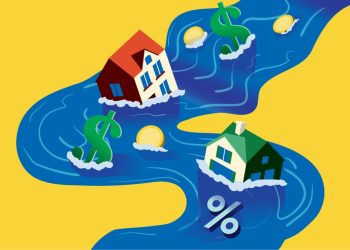Distressed sales—including bank-owned (REO) sales, sales of homes actively in foreclosure, and short sales—accounted for 12.9 percent of all U.S. single-family home and condo sales in Q3 2016. According to ATTOM Data Solutions’ Q3 2016 U.S. Home Sales Report, these numbers are down from 15 percent in the previous quarter and down from 15.9 percent in Q3 2015 to the lowest share of distressed home sales since Q3 2007, when distressed sales accounted for 12.3 percent of all home sales.
The peak in share of distressed sales was Q1 2009 at 43.9 percent of all U.S. single-family home and condo sales.
The report also shows that all-cash purchases accounted for 25.9 percent of all single-family home and condo sales in Q3 2016, down from 27.4 percent in the previous quarter and down from 29.2 percent in Q3 2015 to the lowest level since Q3 2007, when all-cash purchases accounted for 24.3 percent of all home sales.
The peak in share of all-cash purchases was Q1 2011 at 44.8 percent of all U.S. single-family home and condo sales.
“Distressed inventory for sale is virtually non-existent in many of the nation’s hottest housing markets, and when a distressed property is listed for sale in those markets, it often sells quickly and at little or no discount,” says Daren Blomquist, senior vice president at ATTOM Data Solutions. “The scarcity of discounted distressed inventory is chasing away cash buyers and other bargain hunters, but it’s certainly good news for home sellers, who nationwide realized the biggest home price gains since purchase in nine years.
“We are seeing the average seller home price gain since purchase start to wane in some of the highest-priced markets where appreciation is beginning to cool, indicating those markets are past their prime as sellers markets,” Blomquist continues. “Meanwhile, there are still a number of buyers markets across the country where a high level of lingering distress and relatively weak demand from owner-occupant buyers provides investors with plenty of bargain-buying opportunities.”
Q3 home sellers realize biggest gains in San Jose, San Francisco, Portland
Nationwide, homeowners who sold in Q3 2016 sold for an average of $43,000 above their purchase price, a 23 percent average home price gain since purchase—the highest since Q3 2007.
Among 118 metropolitan statistical areas with at least 1,000 single-family and condo sales in the third quarter, those with the highest average home price gain since purchase for home sellers in Q3 2016 were San Jose (68 percent); San Francisco (67 percent); Portland (51 percent); Seattle (51 percent); and Los Angeles (49 percent).
Two of those top five markets—San Francisco and San Jose—saw the average home price gain since purchase decline after peaking in the previous quarter.
Five markets where Q3 2016 home sellers lost home value since purchase
Homeowners who sold in Q3 2016 realized an average loss in home price since purchase in five of the 118 markets analyzed (4 percent): Huntsville, Ala. (5 percent loss); Mobile, Ala. (4 percent loss); Greensboro-High Point, N.C. (2 percent loss); Augusta, Ga. (2 percent loss); and Winston-Salem, N.C. (1 percent loss).
There were five additional markets analyzed where the average profit since purchase for homeowners who sold in Q3 2016 was 3 percent or less: Dayton, Ohio (0 percent); Columbia, S.C. (0 percent); Baton Rouge, La. (1 percent); Cleveland, Ohio (1 percent); and Little Rock, Ark. (3 percent).
Highest share of distressed sales in Toledo, Tucson, Rockford
Among metropolitan statistical areas with at least 1,000 single-family home and condo sales in Q3 2016, those with the highest share of distressed sales in Q3 2016 were Toledo, Ohio (36.4 percent); Tucson, Ariz. (24.4 percent); Rockford, Ill. (23.8 percent); Las Vegas (20.9 percent); and Lakeland-Winter Haven, Fla. (20.1 percent).
Other markets where distressed sales accounted for more than 15 percent of all single-family home and condo sales in Q3 2016 included Chicago, Orlando, Miami, Tampa, Memphis, Baltimore, Jacksonville (Florida), Cleveland, Virginia Beach, and New York.
Lowest share of distressed sales in Anchorage, Austin, Boulder
Metro areas with the lowest share of distressed sales in Q3 2016 were Anchorage, Alaska (3.7 percent); Austin, Texas (4.2 percent); Boulder, Colo. (4.6 percent); Asheville, N.C. (5.4 percent); and Springfield, Mo. (5.7 percent).
Other markets where the share of distressed sales accounted for less than 10 percent of all sales included Dallas, San Antonio, Houston, Denver, San Jose, Nashville, Pittsburgh, Seattle, San Francisco, and Minneapolis-St. Paul.
Biggest bank-owned discounts in Pittsburgh, Toledo, Memphis
The median price of a bank-owned (REO) home in Q3 2016 was $131,500, 43 percent below the overall median price for all homes—up from a 42 percent discount in the previous quarter, but equal to the 43 percent REO discount in Q3 2015.
Metro areas with the biggest REO discount in Q3 2016 were Pittsburgh (67 percent); Toledo, Ohio (66 percent); Memphis (63 percent); Birmingham, Ala. (62 percent); and Philadelphia (62 percent).
Other markets with an REO discount of more than 45 percent in Q3 2016 included Milwaukee, Rochester (New York), Columbus (Ohio), Cleveland, New York, Detroit, St. Louis, Cincinnati, and Baltimore.
For more information, visit www.RealtyTrac.com.











